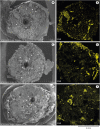Evaluation of tissue ingrowth and reaction of a porous polyethylene block as an onlay bone graft in rabbit posterior mandible
- PMID: 32395389
- PMCID: PMC7192824
- DOI: 10.5051/jpis.2020.50.2.106
Evaluation of tissue ingrowth and reaction of a porous polyethylene block as an onlay bone graft in rabbit posterior mandible
Abstract
Purpose: A new form of porous polyethylene, characterized by higher porosity and pore interconnectivity, was developed for use as a tissue-integrated implant. This study evaluated the effectiveness of porous polyethylene blocks used as an onlay bone graft in rabbit mandible in terms of tissue reaction, bone ingrowth, fibrovascularization, and graft-bone interfacial integrity.
Methods: Twelve New Zealand white rabbits were randomized into 3 treatment groups according to the study period (4, 12, or 24 weeks). Cylindrical specimens measuring 5 mm in diameter and 4.5 mm in thickness were placed directly on the body of the mandible without bone bed decortication, fixed in place with a titanium screw, and covered with a collagen membrane. Histologic and histomorphometric analyses were done using hematoxylin and eosin-stained bone slices. Interfacial shear strength was tested to quantify graft-bone interfacial integrity.
Results: The porous polyethylene graft was observed to integrate with the mandibular bone and exhibited tissue-bridge connections. At all postoperative time points, it was noted that the host tissues had grown deep into the pores of the porous polyethylene in the direction from the interface to the center of the graft. Both fibrovascular tissue and bone were found within the pores, but most bone ingrowth was observed at the graft-mandibular bone interface. Bone ingrowth depth and interfacial shear strength were in the range of 2.76-3.89 mm and 1.11-1.43 MPa, respectively. No significant differences among post-implantation time points were found for tissue ingrowth percentage and interfacial shear strength (P>0.05).
Conclusions: Within the limits of the study, the present study revealed that the new porous polyethylene did not provoke any adverse systemic reactions. The material promoted fibrovascularization and displayed osteoconductive and osteogenic properties within and outside the contact interface. Stable interfacial integration between the graft and bone also took place.
Keywords: Bone regeneration; Bone-implant Interface; Histology; Interfacial shear strength; Polyethylenes; Rabbit.
Copyright © 2020. Korean Academy of Periodontology.
Conflict of interest statement
Conflict of Interest: No potential conflict of interest relevant to this article was reported.
Figures







References
-
- Misch CM. Ridge augmentation using mandibular ramus bone grafts for the placement of dental implants: presentation of a technique. Pract Periodontics Aesthet Dent. 1996;8:127–135. - PubMed
-
- Leonetti JA, Koup R. Localized maxillary ridge augmentation with a block allograft for dental implant placement: case reports. Implant Dent. 2003;12:217–226. - PubMed
-
- Lane JM, Sandhu HS. Current approaches to experimental bone grafting. Orthop Clin North Am. 1987;18:213–225. - PubMed
-
- Prolo DJ, Rodrigo JJ. Contemporary bone graft physiology and surgery. Clin Orthop Relat Res. 1985:322–342. - PubMed
LinkOut - more resources
Full Text Sources

